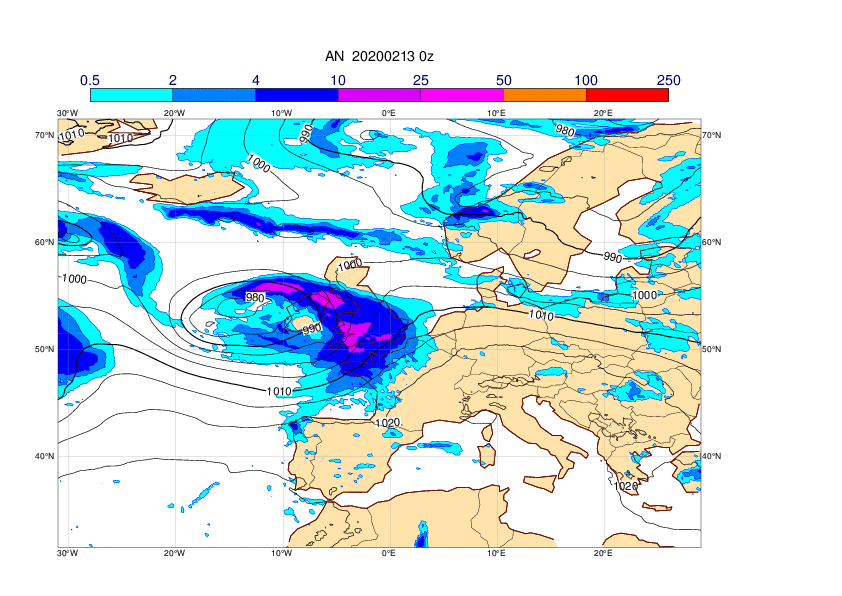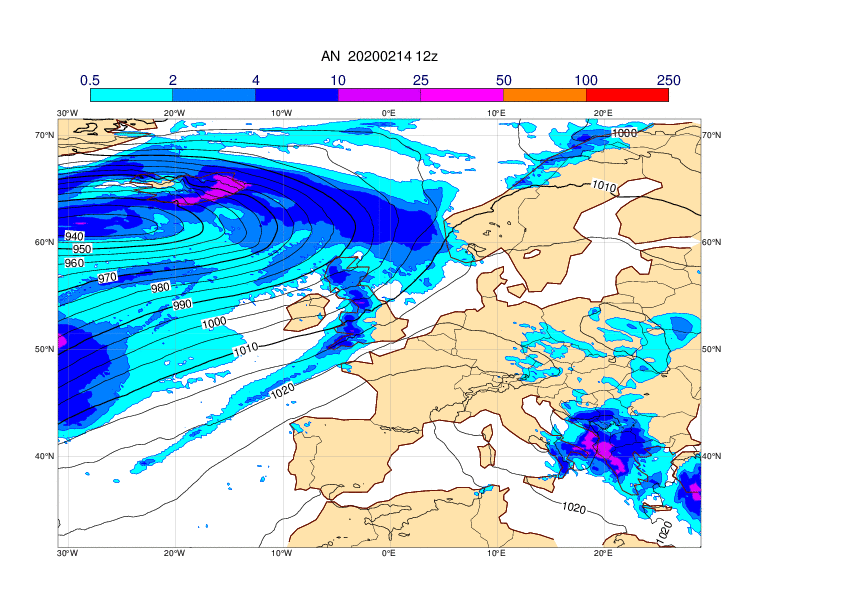Status: Finalised Material from: Linus, Ivan
1. Impact
On 15-16 February the storm Dennis affected the north-western Europe. The cyclone centre was located south of Iceland, and reached a pressure of 919.2 hPa according to the 16 December 00UTC analysis. The cyclone caused widespread flooding in Wales and southern England together with strong winds. The cyclone also led to heavy rainfall in Denmark and southern Sweden where rivers started to flood, as the water levels were already high after Storm Ciara.
https://www.bbc.co.uk/news/in-pictures-51545411
A report from UK Metoffice can be found here: https://www.metoffice.gov.uk/binaries/content/assets/metofficegovuk/pdf/weather/learn-about/uk-past-events/interesting/2020/2020_03_storm_dennis.pdf
2. Description of the event
Satellite Air mass RGB and ECMWF MSLP Analyses at 00 UTC on 16 Feb, 12 UTC on 16 Feb and 00 UTC on 17 Feb. Storm Dennis is labelled.
The pictures below show satellite images from 16 Feb 00UTC, 16 Feb 12UTC and 17 Feb 00UTC. (from yr.no)
The plots below show analyses of MSLP and 6-hour precipitation forecasts every 12h hour between 13 and 17 February.
The plots below show analyses of z500 and t850 every 12h hour between 13 and 17 February.
The precipitation was related to a huge anomaly in the water-vapour flux as seen in the EFI plot further below. Using the software Lagranto we created 6-day backward trajectories that ended over Denmark in the lower troposphere (925-700 hPa) on 16 Feb 12UTC. The plots below show the backward trajectories, with the colour dependent on pressure (left) and specific humidity (right). Some of the moist trajectories had a tropical origin from north of the Caribbean while most of the trajectories picked up the moisture over central Atlantic.
3. Predictability
3.1 Data assimilation
3.2 HRES
The plots below show observations of 24-hour maximum wind gusts valid 15 February 12UTC to 16 February 12UTC (first plot) and HRES forecasts valid at the same period. The forecast plots also includes MSLP valid 16 February 00UTC (grey contours).
The plots below show observations and forecasts of 24-hour precipitation valid from 15 February 06UTC to 16 April 06UTC. The forecast plots also includes MSLP valid 15 February 18UTC.
3.3 ENS
The plots below show EFI and SOT for wind gusts valid 15 February.
The plots below show EFI and SOT for total precipitation valid 15-17 February.
The plots below show EFI and SOT integrated water vapour flux valid 15-17 February.
The plot below shows the evolution of forecast for 24-hour total precipitation valid 15 February 00UTC to 18 February 00UTC for a 2x2 degree box over Wales outlined in the precipitation plots above. The plot includes ensemble (blue box-and-whisker), HRES (red dot) and model climate (red box-and-whisker).
3.4 Monthly forecasts
The plots below show the precipitation anomaly for the week 10-16 February in extended-range forecasts.
The plots below show the MSLP anomaly for the week 10-16 February in extended-range forecasts.
3.5 Comparison with other centres
4. Experience from general performance/other cases
5. Good and bad aspects of the forecasts for the event
- Good signal in extended-range forecasts



















































































